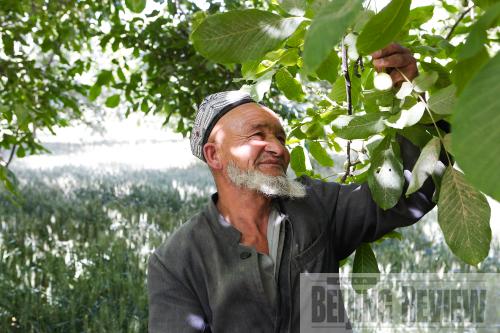|
 |
|
BEARING FRUIT: Farmers in Xinjiang benefit a lot from growing specialty fruits (CHEN JIAN) |
Mijit Kasim, 68, is a farmer living in Dolan New Village, Iganqi Township of Aksu City, Xinjiang Uygur Autonomous Region. Growing 1.3 hectares of cotton and having an orchard of 0.13 hectare, his family, which has four members, earns 35,000 yuan ($5,124.45) annually. In 2006, since the government planned to upgrade the environment along the Dolan River, Mijit Kasim's family, together with 500 other households, was resettled to their present village. Mijit Kasim received 250,000 yuan ($36,603.22) in compensation for his 400-square-meter house. His family then paid 210,000 yuan ($30,746.71) to move into a 288-square-meter villa uniformly built by the government. His family members all participate in the rural cooperative medical system, under which they receive compensation for most medical expenses.
The experience of Mijit Kasim and his family represents the achievements of new countryside construction in Xinjiang, such as specialty fruit trees, earthquake-resistant houses and the rural cooperative medical system.
Growing gold
With exceptionally good conditions of sunshine and fertile soil, Xinjiang has great advantages for growing fruit. The grapes in Turpan, walnuts in Hotan, Chinese dates in Hami, pears in Korla, apples in Aksu and pomegranates in Plyaman are famous all over the country and even the world.
But for a long time, most fruit trees grew in courtyards or scattered across land, and specialty fruit production was confined to a self-supporting small-scale peasant economy. According to figures released by the Forestry Department of Xinjiang Uygur Autonomous Region (FDX), in 1978 when China launched the policy of reform and opening-up, only 103,953 hectares of fruit trees were grown in the region.
Over the past three decades, and especially since 1998, Xinjiang has endeavored to establish fruit production bases. FDX figures show that by the end of 2007, fruit tree growing bases in the region covered 866,667 hectares, with annual output of fruit surpassing 4.5 million tons and the annual output value of the fruit industry reaching 11.4 billion yuan ($1.67 billion).
The fruit industry is contributing more and more to farmers' incomes and has become a new economic growth point. According to FDX figures, in 2007, the per-capita annual income of farmers from the fruit industry stood at 450 yuan ($65.89), contributing 14.3 percent to the total per-capita income of farmers. In some areas where the fruit industry developed earlier than others, the income generated has accounted for more than 50 percent of the total income of farmers. For example, in Piyalma Township of Hotan, which mainly produces pomegranates, the growing area of pomegranates has surpassed 2,000 hectares. The per-capita annual income of local farmers has reached 4,847 yuan ($709.66), with the pomegranate industry contributing 3,102 yuan ($454.17), or 63.9 percent.
|
